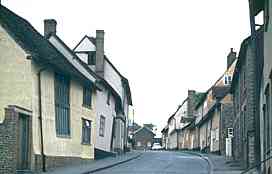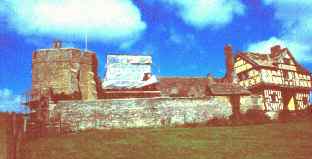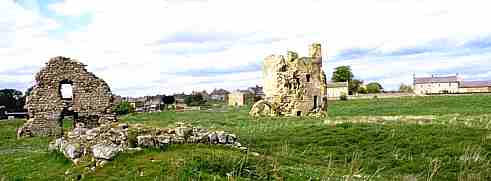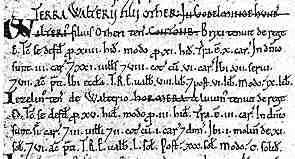 |
|
Deeds |
|
In
our literate and bureaucratic society, the ownership of a parcel of land,
a house or a commercial property involves highly specific and specialised
documentation. In the middle ages, the attesting of ownership changed
from oral to written testimony, but the degree of precision found in the
written documentation of today is a modern phenomenon. Even in the later
medieval era, much still relied on verbal understanding. |
|
|
The
ruins of the castle of Ravensworth in North Yorkshire, with the village behind; a relic of the traditional relationship between feudal landholder and village. |
|
In
rural areas and villages, property holding was tied up with the changing intricacies
of the feudal system. Real estate could not be freely traded, nor could its
disposal be specified in wills. Rights to the use of land were granted progressively
down the feudal tree. |
 |
Late
medieval houses in the wool manufacturing town of Lavenham, Suffolk. |
|
In
towns, merchants and craftsmen could buy and sell town properties. However,
proof of ownership was not recorded in some central register, but was embodied
in the documents recording rights given by grant or negotiated at law. |
|
The
classes of documents which served as title deeds
to land or property are those that have already been discussed in this
section. Charters,
writs or letters
patent served as proof of ownership by grant, while indentures
or final concords
served to document changes of ownership by legal agreement or lawsuit.
The individual documents which were in the hands of landholders or property
owners served as their title deeds. |
|
From
the beginning of the 13th century, royal grants were recorded on chancery
rolls. Monasteries
and aristocrats kept cartularies
in which copies of such documents were recorded for reference. Courts
kept records of cases involving property transfer. If the instrument of
transfer was a final concord, the agreement was recorded in the feet
of fines. Manorial tenants who were involved in cases pertaining to
landholding could receive a copy of the report in the manorial court
roll, which served as a title deed. In other words, there was no central
repository for records of land ownership. |
 |
Stokesay
Castle, a medieval manor house still in a rural setting. |
|
Manorial
lords needed records of the holdings of their tenants, as well as of the
services due to them from those tenants. Various classes of documents
which can be generally categorised under the heading of surveys
were constructed for this purpose. Extents
or terriers listed
the holdings of the tenants of a manor and the rents or services due,
and might include a listing of the stock and crops grown. Rentals
were more concise documents listing tenants, the acreage held by each
and the rent due. Custumals
detailed tenure, as well as the customary law of the manor as followed
in the manorial court. None of these constitute title deeds as such, but
record land tenureship lower down the social scale. |
| The
great grandfather of all land surveys in England was Domesday Book which, with
its various components and addenda, comprised a survey of royal holdings throughout
most of the kingdom. This was a unique document. |
|
|
Segment
from Domesday Book (London, National Archives). |
|
The
earliest Anglo-Saxon diplomas
referring to land grants described the parcel of land in great detail,
with topographical details elaborated so carefully that the boundaries
can be plotted on a modern map. The later form of document derived from
the Anglo-Saxon writ of Edward the Confessor relied much more on oral
knowledge. Right through the middle ages, documents referring to land
grants or transactions identify the plot of land in only the most general
terms, relying on the testimony of living witnesses to deal with any disputed
details. |
|
|
Detail
of a charter of Gervaise Payne to the nuns of Nuneaton, late 12th century
(British Library, add. charter 47424). By permission of the British Library. |
|
The
property in question in this private charter above is described only as
molendinum meum de Ingepenna cum prato et crofto,
my mill at Inkpen with its meadows and crofts. The parties to the agreement
were expected to know which ones. |
|
|
Top
of an indenture of 1190 which deals with ownership of a tenement in Oxford
(Christ Church, Oxford). |
|
Town
properties were described in similarly non-specific ways. The above indenture
refers to a tenement ad portam aquilonarem Oxenfordie,
by the north gate of Oxford. It is not until the 16th century, when the
procedures of surveying and mapmaking became more professional, that reliance
on oral testimony is replaced by more precise written maps and surveys. |
|
Documents
testifying to land ownership or tenure are widely scattered. Original
charters, writs or indentures remained with their owners and can turn
up anywhere, or nowhere. Court records are scattered around England in
regional record offices, or may even be in private hands. Bodies of material
have gravitated into public archives, but in a random fashion. However,
there are vast numbers of surviving documents relating to property holding.
Their investigation is a genuine historian's detective story.
|
 Categories
of Documents Categories
of Documents |
|
 |
 |
 |
 |





